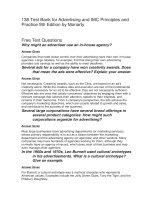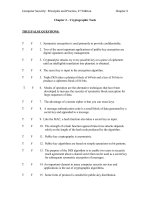Operating systems principles and practice 2nd by thomas anderson
Bạn đang xem bản rút gọn của tài liệu. Xem và tải ngay bản đầy đủ của tài liệu tại đây (19.8 MB, 877 trang )
OperatingSystems
Principles&Practice
VolumeI:KernelsandProcesses
SecondEdition
ThomasAnderson
UniversityofWashington
MikeDahlin
UniversityofTexasandGoogle
RecursiveBooks
recursivebooks.com
OperatingSystems:PrinciplesandPractice(SecondEdition)VolumeI:Kernelsand
ProcessesbyThomasAndersonandMichaelDahlin
Copyright©ThomasAndersonandMichaelDahlin,2011-2015.
ISBN978-0-9856735-3-6
Publisher:RecursiveBooks,Ltd.,
Cover:ReflectionLake,Mt.Rainier
Coverdesign:CameronNeat
Illustrations:CameronNeat
Copyeditors:SandyKaplan,WhitneySchmidt
Ebookdesign:RobinBriggs
Webdesign:AdamAnderson
SUGGESTIONS,COMMENTS,andERRORS.Wewelcomesuggestions,commentsand
errorreports,byemailto
Noticeofrights.Allrightsreserved.Nopartofthisbookmaybereproduced,storedina
retrievalsystem,ortransmittedinanyformbyanymeans—electronic,mechanical,
photocopying,recording,orotherwise—withoutthepriorwrittenpermissionofthe
publisher.Forinformationongettingpermissionsforreprintsandexcerpts,contact
Noticeofliability.Theinformationinthisbookisdistributedonan“AsIs”basis,without
warranty.NeithertheauthorsnorRecursiveBooksshallhaveanyliabilitytoanypersonor
entitywithrespecttoanylossordamagecausedorallegedtobecauseddirectlyor
indirectlybytheinformationorinstructionscontainedinthisbookorbythecomputer
softwareandhardwareproductsdescribedinit.
Trademarks:Throughoutthisbooktrademarkednamesareused.Ratherthanputa
trademarksymbolineveryoccurrenceofatrademarkedname,westateweareusingthe
namesonlyinaneditorialfashionandtothebenefitofthetrademarkownerwithno
intentionofinfringementofthetrademark.Alltrademarksorservicemarksarethe
propertyoftheirrespectiveowners.
ToRobin,Sandra,Katya,andAdam
TomAnderson
ToMarla,Kelly,andKeith
MikeDahlin
Contents
Preface
IKernelsandProcesses
1Introduction
1.1WhatIsAnOperatingSystem?
1.1.1ResourceSharing:OperatingSystemasReferee
1.1.2MaskingLimitations:OperatingSystemasIllusionist
1.1.3ProvidingCommonServices:OperatingSystemasGlue
1.1.4OperatingSystemDesignPatterns
1.2OperatingSystemEvaluation
1.2.1ReliabilityandAvailability
1.2.2Security
1.2.3Portability
1.2.4Performance
1.2.5Adoption
1.2.6DesignTradeoffs
1.3OperatingSystems:Past,Present,andFuture
1.3.1ImpactofTechnologyTrends
1.3.2EarlyOperatingSystems
1.3.3Multi-UserOperatingSystems
1.3.4Time-SharingOperatingSystems
1.3.5ModernOperatingSystems
1.3.6FutureOperatingSystems
Exercises
2TheKernelAbstraction
2.1TheProcessAbstraction
2.2Dual-ModeOperation
2.2.1PrivilegedInstructions
2.2.2MemoryProtection
2.2.3TimerInterrupts
2.3TypesofModeTransfer
2.3.1UsertoKernelMode
2.3.2KerneltoUserMode
2.4ImplementingSafeModeTransfer
2.4.1InterruptVectorTable
2.4.2InterruptStack
2.4.3TwoStacksperProcess
2.4.4InterruptMasking
2.4.5HardwareSupportforSavingandRestoringRegisters
2.5PuttingItAllTogether:x86ModeTransfer
2.6ImplementingSecureSystemCalls
2.7StartingaNewProcess
2.8ImplementingUpcalls
2.9CaseStudy:BootinganOperatingSystemKernel
2.10CaseStudy:VirtualMachines
2.11SummaryandFutureDirections
Exercises
3TheProgrammingInterface
3.1ProcessManagement
3.1.1WindowsProcessManagement
3.1.2UNIXProcessManagement
3.2Input/Output
3.3CaseStudy:ImplementingaShell
3.4CaseStudy:InterprocessCommunication
3.4.1Producer-ConsumerCommunication
3.4.2Client-ServerCommunication
3.5OperatingSystemStructure
3.5.1MonolithicKernels
3.5.2Microkernel
3.6SummaryandFutureDirections
Exercises
II:Concurrency
4.ConcurrencyandThreads
5.SynchronizingAccesstoSharedObjects
6.Multi-ObjectSynchronization
7.Scheduling
III:MemoryManagement
8.AddressTranslation
9.CachingandVirtualMemory
10.AdvancedMemoryManagement
IV:PersistentStorage
11.FileSystems:IntroductionandOverview
12.StorageDevices
13.FilesandDirectories
14.ReliableStorage
References
Glossary
AbouttheAuthors
Preface
PrefacetotheeBookEdition
OperatingSystems:PrinciplesandPracticeisatextbookforafirstcoursein
undergraduateoperatingsystems.Inuseatover50collegesanduniversitiesworldwide,
thistextbookprovides:
Apathforstudentstounderstandhighlevelconceptsallthewaydowntoworking
code.
Extensiveworkedexamplesintegratedthroughoutthetextprovidestudentsconcrete
guidanceforcompletinghomeworkassignments.
Afocusonup-to-dateindustrytechnologiesandpractice
TheeBookeditionissplitintofourvolumesthattogethercontainexactlythesame
materialasthe(2nd)printeditionofOperatingSystems:PrinciplesandPractice,
reformattedforvariousscreensizes.Eachvolumeisself-containedandcanbeusedasa
standalonetext,e.g.,atschoolsthatteachoperatingsystemstopicsacrossmultiple
courses.
Volume1:KernelsandProcesses.ThisvolumecontainsChapters1-3oftheprint
edition.Wedescribetheessentialstepsneededtoisolateprogramstopreventbuggy
applicationsandcomputervirusesfromcrashingortakingcontrolofyoursystem.
Volume2:Concurrency.ThisvolumecontainsChapters4-7oftheprintedition.We
provideaconcretemethodologyforwritingcorrectconcurrentprogramsthatisin
widespreaduseinindustry,andweexplainthemechanismsforcontextswitchingand
synchronizationfromfundamentalconceptsdowntoassemblycode.
Volume3:MemoryManagement.ThisvolumecontainsChapters8-10oftheprint
edition.Weexplainboththetheoryandmechanismsbehind64-bitaddressspace
translation,demandpaging,andvirtualmachines.
Volume4:PersistentStorage.ThisvolumecontainsChapters11-14oftheprint
edition.Weexplainthetechnologiesunderlyingmodernextent-based,journaling,and
versioningfilesystems.
Amoredetaileddescriptionofeachchapterisgivenintheprefacetotheprintedition.
PrefacetothePrintEdition
WhyWeWroteThisBook
Manyofourstudentstellusthatoperatingsystemswasthebestcoursetheytookasan
undergraduateandalsothemostimportantfortheircareers.Wearenotalone—manyof
ourcolleaguesreportreceivingsimilarfeedbackfromtheirstudents.
Partoftheexcitementisthatthecoreideasinamodernoperatingsystem—protection,
concurrency,virtualization,resourceallocation,andreliablestorage—havebecome
widelyappliedthroughoutcomputerscience,notjustoperatingsystemkernels.Whether
yougetajobatFacebook,Google,Microsoft,oranyotherleading-edgetechnology
company,itisimpossibletobuildresilient,secure,andflexiblecomputersystemswithout
theabilitytoapplyoperatingsystemsconceptsinavarietyofsettings.Inamodernworld,
nearlyeverythingauserdoesisdistributed,nearlyeverycomputerismulti-core,security
threatsabound,andmanyapplicationssuchaswebbrowsershavebecomemini-operating
systemsintheirownright.
Itshouldbenosurprisethatformanycomputersciencestudents,anundergraduate
operatingsystemsclasshasbecomeadefactorequirement:atickettoaninternshipand
eventuallytoafull-timeposition.
Unfortunately,manyoperatingsystemstextbooksarestillstuckinthepast,failingtokeep
pacewithrapidtechnologicalchange.Severalwidely-usedbookswereinitiallywrittenin
themid-1980’s,andtheyoftenactasiftechnologystoppedatthatpoint.Evenwhennew
topicsareadded,theyaretreatedasanafterthought,withoutpruningmaterialthathas
becomelessimportant.Theresultaretextbooksthatareverylong,veryexpensive,andyet
failtoprovidestudentsmorethanasuperficialunderstandingofthematerial.
Ourviewisthatoperatingsystemshavechangeddramaticallyoverthepasttwentyyears,
andthatjustifiesafreshlookatbothhowthematerialistaughtandwhatistaught.The
paceofinnovationinoperatingsystemshas,ifanything,increasedoverthepastfewyears,
withtheintroductionoftheiOSandAndroidoperatingsystemsforsmartphones,theshift
tomulticorecomputers,andtheadventofcloudcomputing.
Topreparestudentsforthisnewworld,webelievestudentsneedthreethingstosucceedat
understandingoperatingsystemsatadeeplevel:
Conceptsandcode.Webelieveitisimportanttoteachstudentsbothprinciplesand
practice,conceptsandimplementation,ratherthaneitheralone.Thistextbooktakes
conceptsallthewaydowntothelevelofworkingcode,e.g.,howacontextswitch
worksinassemblycode.Inourexperience,thisistheonlywaystudentswillreally
understandandmasterthematerial.Allofthecodeinthisbookisavailablefromthe
author’swebsite,ospp.washington.edu.
Extensiveworkedexamples.Inourview,studentsneedtobeabletoapplyconcepts
inpractice.Tothatend,wehaveintegratedalargenumberofexampleexercises,
alongwithsolutions,throughoutthetext.Weusestheseexercisesextensivelyinour
ownlectures,andwehavefoundthemessentialtochallengingstudentstogobeyond
asuperficialunderstanding.
Industrypractice.Toshowstudentshowtoapplyoperatingsystemsconceptsina
varietyofsettings,weusedetailed,concreteexamplesfromFacebook,Google,
Microsoft,Apple,andotherleading-edgetechnologycompaniesthroughoutthe
textbook.Becauseoperatingsystemsconceptsareimportantinawiderangeof
computersystems,wetaketheseexamplesnotonlyfromtraditionaloperating
systemslikeLinux,Windows,andOSXbutalsofromothersystemsthatneedto
solveproblemsofprotection,concurrency,virtualization,resourceallocation,and
reliablestoragelikedatabases,webbrowsers,webservers,mobileapplications,and
searchengines.
Takingafreshperspectiveonwhatstudentsneedtoknowtoapplyoperatingsystems
conceptsinpracticehasledustoinnovateineverymajortopiccoveredinan
undergraduate-levelcourse:
KernelsandProcesses.Thesafeexecutionofuntrustedcodehasbecomecentralto
manytypesofcomputersystems,fromwebbrowserstovirtualmachinestooperating
systems.YetexistingtextbookstreatprotectionasasideeffectofUNIXprocesses,as
iftheyaresynonyms.Instead,westartfromfirstprinciples:whataretheminimum
requirementsforprocessisolation,howcansystemsimplementprocessisolation
efficiently,andwhatdostudentsneedtoknowtoimplementfunctionscorrectlywhen
thecallerispotentiallymalicious?
Concurrency.Withtheadventofmulti-corearchitectures,moststudentstodaywill
spendmuchoftheircareerswritingconcurrentcode.Existingtextbooksprovidea
blizzardofconcurrencyalternatives,mostofwhichwereabandoneddecadesagoas
impractical.Instead,wefocusonprovidingstudentsasinglemethodologybasedon
Mesamonitorsthatwillenablestudentstowritecorrectconcurrentprograms—a
methodologythatisbyfarthedominantapproachusedinindustry.
MemoryManagement.Evenasdemand-paginghasbecomelessimportant,
virtualizationhasbecomeevenmoreimportanttomoderncomputersystems.We
provideadeeptreatmentofaddresstranslationhardware,sparseaddressspaces,
TLBs,andon-chipcaches.Wethenusethoseconceptsasaspringboardfor
describingvirtualmachinesandrelatedconceptssuchascheckpointingandcopy-onwrite.
PersistentStorage.Reliablestorageinthepresenceoffailuresiscentraltothe
designofmostcomputersystems.Existingtextbookssurveythehistoryoffile
systems,spendingmostoftheirtimeadhocapproachestofailurerecoveryanddefragmentation.Yetnomodernfilesystemsstillusethoseadhocapproaches.Instead,
ourfocusisonhowfilesystemsuseextents,journaling,copy-on-write,andRAIDto
achievebothhighperformanceandhighreliability.
IntendedAudience
OperatingSystems:PrinciplesandPracticeisatextbookforafirstcoursein
undergraduateoperatingsystems.Webelieveoperatingsystemsshouldbetakenasearly
aspossibleinanundergraduate’scourseofstudy;manystudentsusethecourseasa
springboardtoaninternshipandacareer.Tothatend,wehavedesignedthetextbookto
assumeminimalpre-requisites:specifically,studentsshouldhavetakenadatastructures
courseandoneoncomputerorganization.Thecodeexamplesarewritteninacombination
ofx86assembly,C,andC++.Inparticular,wehavedesignedthebooktointerfacewell
withtheBryantandO’Hallorantextbook.Wereviewandcoverinmuchmoredepththe
materialfromthesecondhalfofthatbook.
Weshouldnotewhatthistextbookisnot:itisnotintendedtoteachtheAPIorinternalsof
anyspecificoperatingsystem,suchasLinux,Android,Windows8,OSX,oriOS.Weuse
manyconcreteexamplesfromthesesystems,butourfocusisonthesharedproblemsthese
systemsfaceandthetechnologiesthesesystemsusetosolvethoseproblems.
AGuidetoInstructors
Oneofourgoalsisenableinstructorstochooseanappropriatelevelofdepthforeach
coursetopic.Eachchapterbeginsataconceptuallevel,withimplementationdetailsand
themoreadvancedmaterialtowardstheend.Themoreadvancedmaterialcanbeomitted
withoutcompromisingtheabilityofstudentstofollowlatermaterial.Nosingle-quarteror
single-semestercourseislikelytobeabletocovereverytopicwehaveincluded,butwe
thinkitisagoodthingforstudentstocomeawayfromanoperatingsystemscoursewith
anappreciationthatthereisalwaysmoretolearn.
Foreachtopic,weattempttoconveyitatthreelevels:
Howtoreasonaboutsystems.Wedescribecoresystemsconcepts,suchas
protection,concurrency,resourcescheduling,virtualization,andstorage,andwe
providepracticeapplyingtheseconceptsinvarioussituations.Inourview,this
providesthebiggestlong-termpayofftostudents,astheyarelikelytoneedtoapply
theseconceptsintheirworkthroughouttheircareer,almostregardlessofwhat
projecttheyendupworkingon.
Powertools.Weintroducestudentstoanumberofabstractionsthattheycanapplyin
theirworkinindustryimmediatelyaftergraduation,andthatweexpectwillcontinue
tobeusefulfordecadessuchassandboxing,protectedprocedurecalls,threads,locks,
conditionvariables,caching,checkpointing,andtransactions.
Detailsofspecificoperatingsystems.Weincludenumerousexamplesofhow
differentoperatingsystemsworkinpractice.However,thismaterialchangesrapidly,
andthereisanorderofmagnitudemorematerialthancanbecoveredinasingle
semester-lengthcourse.Thepurposeoftheseexamplesistoillustratehowtousethe
operatingsystemsprinciplesandpowertoolstosolveconcreteproblems.Wedonot
attempttoprovideacomprehensivedescriptionofLinux,OSX,oranyother
particularoperatingsystem.
Thebookisdividedintofiveparts:anintroduction(Chapter1),kernelsandprocesses
(Chapters2-3),concurrency,synchronization,andscheduling(Chapters4-7),memory
management(Chapters8-10),andpersistentstorage(Chapters11-14).
Introduction.ThegoalofChapter1istointroducetherecurringthemesfoundinthe
laterchapters.Wedefinesomecommonterms,andweprovideabitofthehistoryof
thedevelopmentofoperatingsystems.
TheKernelAbstraction.Chapter2coverskernel-basedprocessprotection—the
conceptandimplementationofexecutingauserprogramwithrestrictedprivileges.
Giventheincreasingimportanceofcomputersecurityissues,webelieveprotected
executionandsafetransferacrossprivilegelevelsareworthtreatingindepth.We
havebrokenthedescriptionintosections,toallowinstructorstochooseeitheraquick
introductiontotheconcepts(upthroughSection2.3),orafulltreatmentofthekernel
implementationdetailsdowntothelevelofinterrupthandlers.Someinstructorsstart
withconcurrency,andcoverkernelsandkernelprotectionafterwards.Whileour
textbookcanbeusedthatway,wehavefoundthatstudentsbenefitfromabasic
understandingoftheroleofoperatingsystemsinexecutinguserprograms,before
introducingconcurrency.
TheProgrammingInterface.Chapter3isintendedasanimpedancematchfor
studentsofdifferingbackgrounds.Dependingonstudentbackground,itcanbe
skippedorcoveredindepth.Thechaptercoverstheoperatingsystemfroma
programmer’sperspective:processcreationandmanagement,device-independent
input/output,interprocesscommunication,andnetworksockets.Ourgoalisthat
studentsshouldunderstandatadetailedlevelwhathappenswhenauserclicksalink
inawebbrowser,astherequestistransferredthroughoperatingsystemkernelsand
userspaceprocessesattheclient,server,andbackagain.Thischapteralsocoversthe
organizationoftheoperatingsystemitself:howdevicedriversandthehardware
abstractionlayerworkinamodernoperatingsystem;thedifferencebetweena
monolithicandamicrokerneloperatingsystem;andhowpolicyandmechanismare
separatedinmodernoperatingsystems.
ConcurrencyandThreads.Chapter4motivatesandexplainstheconceptof
threads.Becauseoftheincreasingimportanceofconcurrentprogramming,andits
integrationwithmodernprogramminglanguageslikeJava,manystudentshavebeen
introducedtomulti-threadedprogramminginanearlierclass.Thisisabitdangerous,
asstudentsatthisstagearepronetowritingprogramswithraceconditions,problems
thatmayormaynotbediscoveredwithtesting.Thus,thegoalofthischapteristo
provideasolidconceptualframeworkforunderstandingthesemanticsof
concurrency,aswellashowconcurrentthreadsareimplementedinboththe
operatingsystemkernelandinuser-levellibraries.Instructorsneedingtogomore
quicklycanomittheseimplementationdetails.
Synchronization.Chapter5discussesthesynchronizationofmulti-threaded
programs,acentralpartofalloperatingsystemsandincreasinglyimportantinmany
othercontexts.Ourapproachistodescribeoneeffectivemethodforstructuring
concurrentprograms(basedonMesamonitors),ratherthantoattempttocover
severaldifferentapproaches.Inourview,itismoreimportantforstudentstomaster
onemethodology.Monitorsareaparticularlyrobustandsimpleone,capableof
implementingmostconcurrentprogramsefficiently.Theimplementationof
synchronizationprimitivesshouldbeincludedifthereistime,sostudentsseethat
thereisnomagic.
Multi-ObjectSynchronization.Chapter6discussesadvancedtopicsinconcurrency
—specifically,thetwinchallengesofmultiprocessorlockcontentionanddeadlock.
Thismaterialisincreasinglyimportantforstudentsworkingonmulticoresystems,
butsomecoursesmaynothavetimetocoveritindetail.
Scheduling.Thischaptercoverstheconceptsofresourceallocationinthespecific
contextofprocessorscheduling.Withtheadventofdatacentercomputingand
multicorearchitectures,theprinciplesandpracticeofresourceallocationhave
renewedimportance.Afteraquicktourthroughthetradeoffsbetweenresponsetime
andthroughputforuniprocessorscheduling,thechaptercoversasetofmore
advancedtopicsinaffinityandmultiprocessorscheduling,power-awareanddeadline
scheduling,aswellasbasicqueueingtheoryandoverloadmanagement.Weconclude
thesetopicsbywalkingstudentsthroughacasestudyofserver-sideload
management.
AddressTranslation.Chapter8explainsmechanismsforhardwareandsoftware
addresstranslation.Thefirstpartofthechaptercovershowhardwareandoperating
systemscooperatetoprovideflexible,sparseaddressspacesthroughmulti-level
segmentationandpaging.Wethendescribehowtomakememorymanagement
efficientwithtranslationlookasidebuffers(TLBs)andvirtuallyaddressedcaches.
WeconsiderhowtokeepTLBsconsistentwhentheoperatingsystemmakeschanges
toitspagetables.Weconcludewithadiscussionofmodernsoftware-based
protectionmechanismssuchasthosefoundintheMicrosoftCommonLanguage
RuntimeandGoogle’sNativeClient.
CachingandVirtualMemory.Cachesarecentraltomanydifferenttypesof
computersystems.Moststudentswillhaveseentheconceptofacacheinanearlier
classonmachinestructures.Thus,ourgoalistocoverthetheoryandimplementation
ofcaches:whentheyworkandwhentheydonot,aswellashowtheyare
implementedinhardwareandsoftware.Wethenshowhowtheseideasareappliedin
thecontextofmemory-mappedfilesanddemand-pagedvirtualmemory.
AdvancedMemoryManagement.Addresstranslationisapowerfultoolinsystem
design,andweshowhowitcanbeusedforzerocopyI/O,virtualmachines,process
checkpointing,andrecoverablevirtualmemory.Asthisismoreadvancedmaterial,it
canbeskippedbythoseclassespressedfortime.
FileSystems:IntroductionandOverview.Chapter11framesthefilesystem
portionofthebook,startingtopdownwiththechallengesofprovidingausefulfile
abstractiontousers.WethendiscusstheUNIXfilesysteminterface,themajor
internalelementsinsideafilesystem,andhowdiskdevicedriversarestructured.
StorageDevices.Chapter12surveysblockstoragehardware,specificallymagnetic
disksandflashmemory.Thelasttwodecadeshaveseenrapidchangeinstorage
technologyaffectingbothapplicationprogrammersandoperatingsystemsdesigners;
thischapterprovidesasnapshotforstudents,asabuildingblockforthenexttwo
chapters.Ifstudentshavepreviouslyseenthismaterial,thischaptercanbeskipped.
FilesandDirectories.Chapter13discussesfilesystemlayoutondisk.Ratherthan
surveyallpossiblefilelayouts—somethingthatchangesrapidlyovertime—we
usefilesystemsasaconcreteexampleofmappingcomplexdatastructuresonto
blockstoragedevices.
ReliableStorage.Chapter14explainstheconceptandimplementationofreliable
storage,usingfilesystemsasaconcreteexample.Startingwiththeadhoctechniques
usedinearlyfilesystems,thechapterexplainscheckpointingandwriteahead
loggingasalternateimplementationstrategiesforbuildingreliablestorage,andit
discusseshowredundancysuchaschecksumsandreplicationareusedtoimprove
reliabilityandavailability.
Wewelcomeandencouragesuggestionsforhowtoimprovethepresentationofthe
material;pleasesendanycommentstothepublisher’swebsite,
Acknowledgements
Wehavebeenincrediblyfortunatetohavethehelpofalargenumberofpeopleinthe
conception,writing,editing,andproductionofthisbook.
WestartedonthejourneyofwritingthisbookoverdinnerattheUSENIXNSDI
conferencein2010.Atthetime,wethoughtperhapsitwouldtakeusthesummerto
completethefirstversionandperhapsayearbeforewecoulddeclareourselvesdone.We
wereverywrong!Itisnoexaggerationtosaythatitwouldhavetakenusalotlonger
withoutthehelpwehavereceivedfromthepeoplewementionbelow.
Perhapsmostimportanthavebeenourearlyadopters,whohavegivenusenormously
usefulfeedbackaswehaveputtogetherthisedition:
Carnegie-Mellon
DavidEckhardtandGarthGibson
Clarkson
JeannaMatthews
Cornell
GunSirer
ETHZurich
MothyRoscoe
NewYorkUniversity
LaskshmiSubramanian
PrincetonUniversity
KaiLi
SaarlandUniversity
PeterDruschel
StanfordUniversity
JohnOusterhout
UniversityofCaliforniaRiverside
HarshaMadhyastha
UniversityofCaliforniaSantaBarbara BenZhao
UniversityofMaryland
NeilSpring
UniversityofMichigan
PeteChen
UniversityofSouthernCalifornia
RameshGovindan
UniversityofTexas-Austin
LorenzoAlvisi
UniverstiyofToronto
DingYuan
UniversityofWashington
GaryKimuraandEdLazowska
Indevelopingourapproachtoteachingoperatingsystems,bothbeforewestartedwriting
andafterwardsaswetriedtoputourthoughtstopaper,wemadeextensiveuseoflecture
notesandslidesdevelopedbyotherfaculty.Ofparticularhelpwerethematerialscreated
byPeteChen,PeterDruschel,SteveGribble,EddieKohler,JohnOusterhout,Mothy
Roscoe,andGeoffVoelker.Wethankthemall.
Ourillustratorforthesecondedition,CameronNeat,hasbeenajoytoworkwith.
WearealsogratefultoLorenzoAlvisi,AdamAnderson,PeteChen,SteveGribble,Sam
Hopkins,EdLazowska,HarshaMadhyastha,JohnOusterhout,MarkRich,MothyRoscoe,
WillScott,GunSirer,IonStoica,LakshmiSubramanian,andJohnZahorjanfortheir
helpfulcommentsandsuggestionsastohowtoimprovethebook.
WethankJoshBerlin,MarlaDahlin,SandyKaplan,JohnOusterhout,WhitneySchmidt,
andMikeWalfishforhelpingusidentifyandcorrectgrammaticalortechnicalbugsinthe
text.
WethankJeffDean,GarthGibson,MarkOskin,SimonPeter,DaveProbert,AminVahdat,
andMarkZbikowskifortheirhelpinexplainingtheinternalworkingsofsomeofthe
commercialsystemsmentionedinthisbook.
WewouldliketothankDaveWetherall,DanWeld,MikeWalfish,DavePatterson,Olav
Kvern,DanHalperin,ArmandoFox,RobinBriggs,KatyaAnderson,SandraAnderson,
LorenzoAlvisi,andWilliamAdamsfortheirhelpandadviceontextbookeconomicsand
production.
TheHelenRiaboffWhiteleyCenteraswellasDonandJeanneDahlinwerekindenough
tolendusaplacetoescapewhenweneededtogetchapterswritten.
Finally,wethankourfamilies,ourcolleagues,andourstudentsforsupportingusinthis
larger-than-expectedeffort.
I
KernelsandProcesses
1.Introduction
AllIreallyneedtoknowIlearnedinkindergarten.—RobertFulgham
Howdoweconstructreliable,portable,efficient,andsecurecomputersystems?An
essentialcomponentisthecomputer’soperatingsystem—thesoftwarethatmanagesa
computer’sresources.
First,thebadnews:operatingsystemsconceptsareamongthemostcomplexincomputer
science.Amodern,general-purposeoperatingsystemcanexceed50millionlinesofcode,
orinotherwords,morethanathousandtimeslongerthanthistextbook.Newoperating
systemsarebeingwrittenallthetime:ifyouuseane-bookreader,tablet,orsmartphone,
anoperatingsystemismanagingyourdevice.Giventhisinherentcomplexity,welimitour
focustotheessentialconceptsthateverycomputerscientistshouldknow.
Nowthegoodnews:operatingsystemsconceptsarealsoamongthemostaccessiblein
computerscience.Manytopicsinthisbookwillseemfamiliartoyou—ifyouhaveever
triedtodotwothingsatonce,orpickedthe“wrong”lineatagrocerystore,ortriedto
keeparoommateorsiblingfrommessingwithyourthings,orsucceededatpullingoffan
AprilFool’sjoke.Eachoftheseactivitieshasananalogueinoperatingsystems.Itisthis
familiaritythatgivesushopethatwecanexplainhowoperatingsystemsworkinasingle
textbook.Allweassumeofthereaderisabasicunderstandingoftheoperationofa
computerandtheabilitytoreadpseudo-code.
Webelievethatunderstandinghowoperatingsystemsworkisessentialforanystudent
interestedinbuildingmoderncomputersystems.Ofcourse,everyonewhousesa
computerorasmartphone—orevenamoderntoaster—usesanoperatingsystem,so
understandingthefunctionofanoperatingsystemisusefultomostcomputerscientists.
Thisbookaimstogomuchdeeperthanthat,toexplainoperatingsysteminternalsthatwe
relyoneverydaywithoutrealizingit.
Softwareengineersusemanyofthesametechnologiesanddesignpatternsasthoseused
inoperatingsystemstobuildothercomplexsystems.Whetheryourgoalistoworkonthe
internalsofanoperatingsystemkernel—ortobuildthenextgenerationofsoftwarefor
cloudcomputing,securewebbrowsers,gameconsoles,graphicaluserinterfaces,media
players,databases,ormulticoresoftware—theconceptsandabstractionsneededfor
reliable,portable,efficientandsecuresoftwarearemuchthesame.Inourexperience,the
bestwaytolearntheseconceptsistostudyhowtheyareusedinoperatingsystems,but
wehopeyouwillapplythemtoamuchbroaderrangeofcomputersystems.
Togetstarted,considerthewebserverinFigure1.1.Itsbehaviorisamazinglysimple:it
receivesapacketcontainingthenameofthewebpagefromthenetwork,asanHTTP
GETrequest.Thewebserverdecodesthepacket,readsthefilefromdisk,andsendsthe
contentsofthefilebackoverthenetworktotheuser’smachine.
Figure1.1:Theoperationofawebserver.TheclientmachinesendsanHTTPGETrequesttothewebserver.The
serverdecodesthepacket,readsthefile,andsendsthecontentsbacktotheclient.
Partofanoperatingsystem’sjobistomakeiteasytowriteapplicationslikewebservers.
Butdiggingabitdeeper,thissimplestoryquicklyraisesasmanyquestionsasitanswers:
Manywebrequestsinvolvebothdataandcomputation.Forexample,theGoogle
homepagepresentsasimpletextbox,buteachsearchqueryenteredinthatbox
consultsdataspreadovermanymachines.Tokeeptheirsoftwaremanageable,web
serversofteninvokehelperapplications,e.g.,tomanagetheactualsearchfunction.
Themainwebservermustbeabletocommunicatewiththehelperapplicationsfor
thistowork.Howdoestheoperatingsystemenablemultipleapplicationsto
communicatewitheachother?
Whatiftwousers(oramillion)requestawebpagefromtheserveratthesametime?
Asimpleapproachmightbetohandleeachrequestinturn.Ifanyindividualrequest
takesalongtime,however,everyotherrequestmustwaitforittocomplete.Afaster,
butmorecomplex,solutionistomultitask:tojugglethehandlingofmultiplerequests
atonce.Multitaskingisespeciallyimportantonmodernmulticorecomputers,where
eachprocessorcanhandleadifferentrequestatthesametime.Howdoesthe
operatingsystemenableapplicationstodomultiplethingsatonce?
Forbetterperformance,thewebservermightwanttokeepacopy,sometimescalled
acache,ofrecentlyrequestedpages.Inthisway,ifmultipleusersrequestthesame
page,theservercanrespondtosubsequentrequestsmorequicklyfromthecache,
ratherthanstartingeachrequestfromscratch.Thisrequiresthewebserverto
coordinate,orsynchronize,accesstothecache’sdatastructuresbypossibly
thousandsofwebrequestsatthesametime.Howdoestheoperatingsystem
synchronizeapplicationaccesstoshareddata?
Tocustomizeandanimatetheuserexperience,webserverstypicallysendclients
scriptingcodealongwiththecontentsofthewebpage.Butthismeansthatclicking
onalinkcancausesomeoneelse’scodetorunonyourcomputer.Howdoesthe
clientoperatingsystemprotectitselffromcompromisebyacomputervirus
surreptitiouslyembeddedintothescriptingcode?
Supposethewebsiteadministratorusesaneditortoupdatethewebpage.Theweb
servermustbeabletoreadthisfile.Howdoestheoperatingsystemstorethebyteson
disksothatthewebservercanfindandreadthem?
Takingthisastepfurther,theadministratormaywanttomakeaconsistentsetof
changestothewebsitesothatembeddedlinksarenotleftdangling,even
temporarily.Howcantheoperatingsystemletusersmakeasetofchangestoaweb
site,sothatrequestsseeeithertheoldornewpages,butnotacombinationofthe
two?
Whathappenswhentheclientbrowserandthewebserverrunatdifferentspeeds?If
theservertriestosendawebpagetotheclientfasterthantheclientcanrenderthe
pageonthescreen,wherearethecontentsofthefilestoredinthemeantime?Canthe
operatingsystemdecoupletheclientandserversothateachcanrunatitsownspeed
withoutslowingtheotherdown?
Asdemandonthewebservergrows,theadministratormayneedtomovetomore
powerfulhardware,withmorememory,moreprocessors,fasternetworkdevices,and
fasterdisks.Totakeadvantageofnewhardware,mustthewebserverbere-written
eachtime,orcanitbewritteninahardware-independentfashion?Whataboutthe
operatingsystem—mustitbere-writtenforeverynewpieceofhardware?
Wecouldgoon,butyougettheidea.Thisbookwillhelpyouunderstandtheanswersto
theseandmanymorequestions.
Chapterroadmap:
Therestofthischapterdiscussesthreetopicsindetail:
OperatingSystemDefinition.Whatisanoperatingsystem,andwhatdoesitdo?
(Section1.1)
OperatingSystemEvaluation.Whatdesigngoalsshouldwelookforinan
operatingsystem?(Section1.2)
OperatingSystems:Past,Present,andFuture.Howhaveoperatingsystems
evolved,andwhatnewfunctionalityarewelikelytoseeinfutureoperatingsystems?
(Section1.3)
1.1WhatIsAnOperatingSystem?
Anoperatingsystem(OS)isthelayerofsoftwarethatmanagesacomputer’sresourcesfor
itsusersandtheirapplications.Operatingsystemsruninawiderangeofcomputer
systems.Theymaybeinvisibletotheenduser,controllingembeddeddevicessuchas
toasters,gamingsystems,andthemanycomputersinsidemodernautomobilesand
airplanes.Theyarealsoessentialtomoregeneral-purposesystemssuchassmartphones,
desktopcomputers,andservers.
Ourdiscussionwillfocusongeneral-purposeoperatingsystemsbecausethetechnologies
theyneedareasupersetofthoseneededforembeddedsystems.Increasingly,operating
systemstechnologiesdevelopedforgeneral-purposecomputingaremigratingintothe
embeddedsphere.Forexample,earlymobilephoneshadsimpleoperatingsystemsto
managetheirhardwareandtorunahandfulofprimitiveapplications.Today,smartphones
—phonescapableofrunningindependentthird-partyapplications—arethefastest
growingsegmentofthemobilephonebusiness.Thesedevicesrequiremuchmore
completeoperatingsystems,withsophisticatedresourcemanagement,multi-tasking,
securityandfailureisolation.
Likewise,automobilesareincreasinglysoftwarecontrolled,raisingahostofoperating
systemissues.Cananyonewritesoftwareforyourcar?Whatifthesoftwarefailswhile
youaredrivingdownthehighway?Canacar’soperatingsystembehijackedbya
computervirus?Althoughthismightseemfar-fetched,researchersrecentlydemonstrated
thattheycouldremotelyturnoffacar’sbrakingsystemthroughacomputervirus
introducedintothecar’scomputersviaahackedcarradio.Agoalofthisbookisto
explainhowtobuildmorereliableandsecurecomputersystemsinavarietyofcontexts.
Figure1.2:Ageneral-purposeoperatingsystemisalayerofsoftwarethatmanagesacomputer’sresourcesforitsusers
andapplications.
Forgeneral-purposesystems,usersinteractwithapplications,applicationsexecuteinan
environmentprovidedbytheoperatingsystem,andtheoperatingsystemmediatesaccess
totheunderlyinghardware,asshowninFigure1.2andexpandedinFigure1.3.Howcan
anoperatingsystemrunmultipleapplications?Forthis,operatingsystemsneedtoplay
threeroles:
Figure1.3:Thisshowsthestructureofageneral-purposeoperatingsystem,asanexpansiononthesimpleview
presentedinFigure1.2.Atthelowestlevel,thehardwareprovidesprocessors,memory,andasetofdevicesforstoring
dataandcommunicatingwiththeoutsideworld.Thehardwarealsoprovidesprimitivesthattheoperatingsystemcan
useforfaultisolationandsynchronization.Theoperatingsystemrunsasthelowestlayerofsoftwareonthecomputer.
Itcontainsbothadevice-specificlayerformanagingthemyriadhardwaredevicesandasetofdevice-independent
servicesprovidedtoapplications.Sincetheoperatingsystemmustisolatemaliciousandbuggyapplicationsfromother
applicationsortheoperatingsystemitself,muchoftheoperatingsystemrunsinaseparateexecutionenvironment
protectedfromapplicationcode.Aportionoftheoperatingsystemcanalsorunasasystemlibrarylinkedintoeach
application.Inturn,applicationsruninanexecutioncontextprovidedbytheoperatingsystemkernel.Theapplication
contextismuchmorethanasimpleabstractionontopofhardwaredevices:applicationsexecuteinavirtual
environmentthatismoreconstrained(topreventharm),morepowerful(tomaskhardwarelimitations),andmoreuseful
(viacommonservices)thantheunderlyinghardware.
1. Referee.Operatingsystemsmanageresourcessharedbetweendifferentapplications
runningonthesamephysicalmachine.Forexample,anoperatingsystemcanstop









